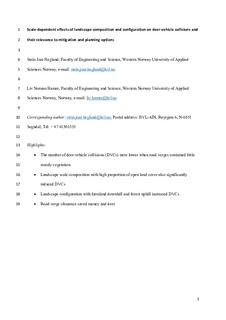| dc.contributor.author | Hegland, Stein Joar | |
| dc.contributor.author | Hamre, Liv Norunn | |
| dc.coverage.spatial | Norway | nb_NO |
| dc.date.accessioned | 2019-03-11T08:56:15Z | |
| dc.date.available | 2019-03-11T08:56:15Z | |
| dc.date.created | 2018-04-06T14:30:31Z | |
| dc.date.issued | 2018 | |
| dc.identifier.citation | Hegland, S. J., & Hamre, L. N. (2018). Scale-dependent effects of landscape composition and configuration on deer-vehicle collisions and their relevance to mitigation and planning options. Landscape and Urban Planning, 169, 178-184. | nb_NO |
| dc.identifier.issn | 0169-2046 | |
| dc.identifier.uri | http://hdl.handle.net/11250/2589495 | |
| dc.description | Author'r accepted version (post-print). | nb_NO |
| dc.description | Available: 2020-09-21. | |
| dc.description.abstract | Deer-vehicle collisions (DVCs) cause animal suffering, traffic safety problems and socioeconomic costs and must be assessed in landscape planning and road management. We investigated whether landscape composition and configuration across spatial scales could predict DVCs and be used for mitigation actions and planning processes. We used data on DVCs between vehicles and red deer (Cervus elaphus) in Western Norway. We mapped DVCs and quantified open land cover within 10, 100 and 1000 m buffers as we expected scale-dependent effects on DVCs. A linear mixed effect model showed that DVCs was lower with higher proportion of open land on road verge scale (10 m-buffer) and ca. 50% lower DVC frequency when proportion of open land was increased from 60 to 100%. DVCs was generally lower in landscapes (100- and 1000 m buffers) composed of land that is more open. DVCs was 77% higher in areas with spatial configuration of forest uphill and farmland downhill (FUFD). Landscape composition had the largest effect at fine spatial scale, whereas configuration mattered most at coarser scales, indicating scale-dependency. A case study of clearance along a 600 m road section verified the road verge effect compared to a control site, this saved four deer each year, and the payback time was less than one year providing a clear incentive to manage vegetation in road verges. In conclusion, new roads should preferably be planned in open landscapes or areas without FUFD configuration and road verge clearance is an effective mitigation measure to reduce DVCs. | nb_NO |
| dc.language.iso | eng | nb_NO |
| dc.publisher | Elsevier | nb_NO |
| dc.rights | Attribution-NonCommercial-NoDerivatives 4.0 Internasjonal | * |
| dc.rights.uri | http://creativecommons.org/licenses/by-nc-nd/4.0/deed.no | * |
| dc.subject | collision risk | nb_NO |
| dc.subject | configuration | nb_NO |
| dc.subject | landscape planning | nb_NO |
| dc.subject | road management | nb_NO |
| dc.subject | wildlife | nb_NO |
| dc.title | Scale-dependent effects of landscape composition and configuration on deer-vehicle collisions and their relevance to mitigation and planning options | nb_NO |
| dc.type | Journal article | nb_NO |
| dc.type | Peer reviewed | nb_NO |
| dc.description.version | acceptedVersion | nb_NO |
| dc.rights.holder | © 2018. This manuscript version is made available under the CC-BY-NC-ND 4.0 license http://creativecommons.org/licenses/by-nc-nd/4.0/ | nb_NO |
| dc.subject.nsi | VDP::Samfunnsvitenskap: 200::Urbanisme og fysisk planlegging: 230::Landskapsplanlegging: 236 | nb_NO |
| dc.source.pagenumber | 178-184 | nb_NO |
| dc.source.volume | 169 | nb_NO |
| dc.source.journal | Landscape and Urban Planning | nb_NO |
| dc.identifier.doi | 10.1016/j.landurbplan.2017.09.009 | |
| dc.identifier.cristin | 1577977 | |
| cristin.unitcode | 203,12,7,0 | |
| cristin.unitname | Institutt for miljø- og naturvitskap | |
| cristin.ispublished | true | |
| cristin.fulltext | postprint | |
| cristin.qualitycode | 2 | |
| dc.date.embargoenddate | 2020-09-21 | |

